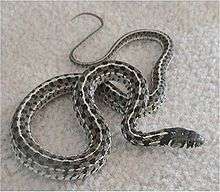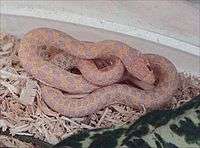Checkered garter snake
| Checkered garter snake | |
|---|---|
 | |
| Scientific classification | |
| Kingdom: | Animalia |
| Phylum: | Chordata |
| Class: | Reptilia |
| Order: | Squamata |
| Suborder: | Serpentes |
| Family: | Colubridae |
| Genus: | Thamnophis |
| Species: | T. marcianus |
| Binomial name | |
| Thamnophis marcianus | |
| Synonyms[2] | |
The checkered garter snake (Thamnophis marcianus) is a species of garter snake endemic to the southwestern United States, Mexico, and Central America.
Etymology
The specific epithet, marcianus, is in honor of American Brigadier General Randolph B. Marcy, who led surveying expeditions to the frontier areas in the mid 19th century.[3]
Description
The checkered garter snake is typically greenish in color, with a distinct, black checkerboard pattern down its back. It is capable of growing to a total length (including tail) of 42 in (107 cm), but 28 in (71 cm) is closer to average.
Habitat
T. marcianus may be found in a variety of habitats that are endemic to the southwestern United States, Mexico, and Central America.
Diet
The diet of T. marcianus includes small frogs, toads, small fish, and earthworms. If kept as a pet, they can be trained on live or freeze - thawed mice, but even so, they are fussy eaters and can suddenly start to refuse mice at any point.
Defensive behavior
T. marcianus will strike and bite if provoked. It will also release a foul-smelling liquid from its cloaca onto attackers.
Venom
T. marcianus has been found to have mild venom.
Subspecies
The three recognized subspecies of T. marcianus are:
Nota bene: A trinomial authority in parentheses indicates that the subspecies was originally described in a genus other than Thamnophis.

In captivity
The checkered garter snake is the easiest garter snake to tame. Even a wild-caught one can become tame in a few days if handled carefully. The checkered garter snake is frequently available in the exotic pet trade, and makes a hardy captive animal. It can be trained to accept mice or fish fillets as food. Captive breeding, while not common, is done, and albino variants are being produced.
References
- ↑ Chaves G, Lamar W, Porras LW, Solórzano A, Sunyer J, Hammerson GA (2013). "Thamnophis marcianus". The IUCN Red List of Threatened Species. IUCN. 2013: e.T198521A2529116. doi:10.2305/IUCN.UK.2013-2.RLTS.T198521A2529116.en. Retrieved 13 January 2018.
- ↑ "Thamnophis marcianus". The Reptile Database. www.reptile-database.org.
- ↑ Beolens B, Watkins M, Grayson M. 2011. The Eponym Dictionary of Reptiles. Baltimore: Johns Hopkins University Press. xiii + 296 pp. ISBN 978-1-4214-0135-5. (Thamnophis marcianus, p. 168).
External links
- Species Thamnophis marcianus at The Reptile Database
Further reading
| Wikimedia Commons has media related to Thamnophis marcianus. |
- Baird SF, Girard CF. 1853. Catalogue of North American Reptiles in the Museum of the Smithsonian Institution. Part I.—Serpents. Washington, District of Columbia: Smithsonian Institution. xvi + 172 pp. (Eutainia marciana, new species, pp. 36–37).
- Behler JL, King FW. 1979. The Audubon Society Field Guide to North American Reptiles and Amphibians. New York: Alfred A. Knopf, Inc. 743 pp. ISBN 0-394-50824-6. (Thamnophis marcianus, p. 669 + Plate 515).
- Schmidt KP, Davis DD. 1941. Field Book of Snakes of the United States and Canada. New York: G.P. Putnam's Sons. 365 pp. (Thamnophis marcianus, pp. 241–243).
- Smith HM, Brodie ED Jr. 1982. Reptiles of North America: A Guide to Field Identification. New York: Golden Press. 240 pp. ISBN 0-307-13666-3. (Thamnophis marcianus, pp. 150–151).
- Stebbins RC. 2003. A Field Guide to Western Reptiles and Amphibians, Third Edition. The Peterson Field Guide Series ®. Boston and New York: Houghton Mifflin Company. xiii + 533 pp. ISBN 978-0-395-98272-3. (Thamnophis marcianus, p. 389 + Plate 50 + Map 159).
- Stejneger L, Barbour T. 1917. A Check List of North American Amphibians and Reptiles. Cambridge, Massachusetts: Harvard University Press. 125 pp. (Thamnophis marcianus, p. 101).
- Wright AH, Wright AA. 1957. Handbook of Snakes of the United States and Canada. Ithaca and London: Comstock Publishing Associates. 1,105 pp. (in two volumes). (Thamnophis marcianus, pp. 802–806, Figure 231 + Map 58 on p. 763).
